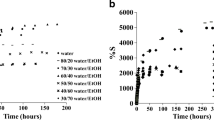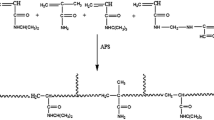Abstract
Series of hydrogels based on polyacrylamide and copolymer dextran-graft-polyacrylamide with various cross-linking density and various molecular weight of dextran component were prepared using N,N′-methylene-bis-acrylamide as cross-linking agent. The comparative equilibrium swelling capacity of synthesized hydrogels was studied. The swelling behavior was analyzed as a function of the polymeric composition, cross-linking degree and hydrolysis degree, ionic strength. It was found that cross-linking degree and molecular weight of polysaccharide component determines the internal structure (mesh size) of hydrogels and affects their swelling capacity. A significant increase in the swelling parameters of hydrogels was achieved due to the hydrolysis of amide groups of the polyacrylamide component of hydrogels. It was registered the high sensitivity of swelling capacity of hydrogels towards ionic strength of the external solution. The absorption and desorption of methylene blue in non-hydrolyzed hydrogels were carried out. Hydrogels were characterized by FTIR and SEM methods.
Access this chapter
Tax calculation will be finalised at checkout
Purchases are for personal use only
Similar content being viewed by others
References
Rodigues IR, Forte MMC, Azambuja DS, Castagno KRL (2007) Synthesis and characterization of hybrid polymeric networks (HPN) based on poly (vinyl alcohol)/chitosan. React Funct Polym 67:708–715
Cui J, Campo A (2012) Multivalent H-bonds for self-healing hydrogels. Chem Commun 48:9302–9304
Picchioni F, Muljana H (2018) Hydrogels based on dynamic covalent and non covalent bonds: a chemistry perspective. Gels 4:21–31
Peppas NA, Hilt ZJ, Khademhosseini A, Langer R (2006) Hydrogels in biology and medicine: from molecular principles to bionanotechnology. Adv Mater 18:1345–1360
Allan SH (2002) Hydrogels for biomedical applications. Adv Drug Deliver Rev 43:3–12
Mathur AM, Moorjani ShK, Scranton AB (1996) Methods for synthesis of hydrogel networks: a review. J Macromol Sci C 36(2):405–430
Cascone MG, Barbani N, Cristallini C, Giusti P, Ciardelli G, Lazzeri L (2001) Bioartificial polymeric materials based on polysaccharides. J Biomater Sci Polym Edn 12(3):267–281
Kim IS, Oh IJ (2005) Drug release from the enzyme-degradable and pH-sensitive hydrogel composed of glycidyl methacrylate dextran and poly(acrylic acid). Arch Pharmacal Res 28:983–988
Kutsevol N, Chumachenko V, Rawiso M, Shyichuk A (2016) Micro Nano Lett 11(5):256–260
Nadtoka O, Kutsevol N, Krysa V, Krysa B (2018) Hybrid polyacryamide hydrogels: synthesis, properties and prospects of application. Mol Cryst Liquid Cryst 672(1):1–10
Kutsevol N, Bezugla T, Bezuglyi M, Rawiso M (2012) Branched dextran-graft-polyacrylamide copolymers as perspective materials for nanotechnology. Macromol Symp 317–318:82–90
Kutsevol N, Guenet JM, Melnyk N, Sarazin D, Rochas C (2006) Solution properties of dextran-polyacrylamide graft copolymers. Polymer 47:2061–2068
Silverstein RM, Webster FX (1998) Spectrometric identification of organic compounds, 6th edn. Wiley, NewYork
Kutsevol NV, Chumachenko VA, RawisoM Shkodich VF, Stoyanov OV (2015) Star-like polymers dextran-polyacrylamide: the prospects of application for nanotechnology. J Struct Chem 56(5):1016–1023
Wu J, Wei Y, Lin J, Lin S (2003) Study on starchg-acrylamide/mineral powder superabsorbent composite. Polymer 44:6513–6520
Zhao Y, Su H, Fang L, Tan T (2005) Superabsorbent hydrogels from poly(asparticacid) with salt, temperature and pH-responsiveness properties. Polymer 46:5368–5376
Vishal Gupta N, Shivakumar HG (2012) Investigation of swelling behavior and mechanical properties of a pH-sensitive superporous hydrogel composite. Iran J Pharm Res 11(2):481–493
Author information
Authors and Affiliations
Corresponding author
Editor information
Editors and Affiliations
Rights and permissions
Copyright information
© 2020 Springer Nature Switzerland AG
About this paper
Cite this paper
Nadtoka, O., Virych, P., Kutsevol, N. (2020). Investigation of Swelling Behavior of PAA and D-PAA Hydrogels. In: Fesenko, O., Yatsenko, L. (eds) Nanooptics and Photonics, Nanochemistry and Nanobiotechnology, and Their Applications . Springer Proceedings in Physics, vol 247. Springer, Cham. https://doi.org/10.1007/978-3-030-52268-1_4
Download citation
DOI: https://doi.org/10.1007/978-3-030-52268-1_4
Published:
Publisher Name: Springer, Cham
Print ISBN: 978-3-030-52267-4
Online ISBN: 978-3-030-52268-1
eBook Packages: Physics and AstronomyPhysics and Astronomy (R0)




